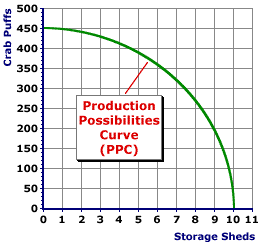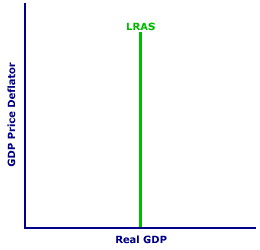
|
|
EXCHANGE RATES, AGGREGATE DEMAND DETERMINANT: One of several specific aggregate demand determinants assumed constant when the aggregate demand curve is constructed, and that shifts the aggregate demand curve when it changes. An increase in exchanges rates causes an increase (rightward shift) of the aggregate curve. A decrease in the exchanges rates causes a decrease (leftward shift) of the aggregate curve. Other notable aggregate demand determinants include interest rates, the money supply, inflationary expectations, consumer confidence, and the federal deficit.
Visit the GLOSS*arama
|
|


|

|
                           FULL EMPLOYMENT: The state that occurs when all of the economy's resources are engaged in the production of output. In practice, an economy is considered to be at full employment when the unemployment rate is around 5 to 5 1/2 percent and the capacity utilization rate of capital is about 85 percent. This is one of the five economic goals and three macroeconomic goals. Full employment is achieved in principle when all available resources (labor, capital, land, and entrepreneurship) are used to produce goods and services. This goal is commonly indicated by the employment of labor resources (measured by the unemployment rate). However, all resources in the economy--labor, capital, land, and entrepreneurship--are important to this goal. The economy benefits from full employment because resources produce the goods that satisfy the wants and needs that lessen the scarcity problem. If the resources are not employed, then they are not producing and satisfaction is not achieved.Graphical Indications| Production Possibilities |  | Aggregate Market |  |
Full employment plays in important role in several graphical analyses. The two most common are the production possibilities model and the aggregate market model (or AS-AD analysis).- Production Possibilities: Full employment is indicated by the boundary of the production possibilities frontier. The production possibilities frontier is constructed under the assumption that all available resources are engaged in production of two goods. As such being on the frontier is, by definition, tantamount to full employment.
- Aggregate Market: Full employment is indicated by the position of the long-run aggregate supply curve. The long-run aggregate supply curve is constructed based on the assumption that flexible prices have adjusted to achieve equilibrium in all markets. Most important, resource markets are in equilibrium, with quantities demanded equal to quantities supplied. In other words, for the labor market, the number of jobs available matches the number of workers available.
Natural UnemploymentFull employment is usually equated with natural unemployment, which is the amount of unemployment consistent with an expanding, growing economy that has no inflation. This is usually considered the combination of structural and frictional unemployment, but no cyclical unemployment. Historical evidence indicates that a 5 to 5 1/2 percent unemployment rate meets these conditions. If the unemployment rate drops much below 5 to 5 1/2 percent, then the inflation rate increases, suggesting that the economy is trying to produce more output than it is capable of doing. However, some contend that full employment exists at a higher unemployment rate, while others argue that a lower unemployment rate is correct. The Politics of Full EmploymentThe macroeconomic goal of full employment would seem to be universally acknowledged as a beneficial pursuit. That, however, is not necessarily the case. At the very least, some are extremely passionate about achieving full employment. Others might even find full employment somewhat objectionable.Consider the two basic political philosophies--liberals and conservatives. - Liberals: Those who comprise the working class and occupy the lower end of the income spectrum, tend to favor the pursuit of full employment more than most. They are the ones most likely harmed by unemployment and thus to benefit from full employment. Liberal politicians count these folks among their core constituency.
- Conservatives: Those who own businesses and are on the employer side of labor markets tend to be less inclined to think full employment is a beneficial state of the economy. Because everyone already has a job, full employment makes it more difficult and costly to hire new workers. A little bit of unemployment tends to make hiring easier. Conservative politicians count these folks among their core constituency.

Recommended Citation:FULL EMPLOYMENT, AmosWEB Encyclonomic WEB*pedia, http://www.AmosWEB.com, AmosWEB LLC, 2000-2025. [Accessed: June 30, 2025].
Check Out These Related Terms... | | | | | | | |
Or For A Little Background... | | | | |
And For Further Study... | | | | | | | | |
Search Again?
Back to the WEB*pedia
|



|

|
PINK FADFLY
[What's This?]
Today, you are likely to spend a great deal of time at an auction looking to buy either a wall poster commemorating the first day of spring or a lazy Susan for you dining room table. Be on the lookout for a thesaurus filled with typos.
Your Complete Scope
This isn't me! What am I?
|

|
|
Cyrus McCormick not only invented the reaper for harvesting grain, he also invented the installment payment for selling his reaper.
|

|
|
"I learned about the strength you can get from a close family life. I learned to keep going, even in bad times. I learned not to despair, even when my world was falling apart. I learned that there are no free lunches. And I learned the value of hard work. " -- Lee Iacocca
|

|
FCF
Free Cash Flow
|

|
|
Tell us what you think about AmosWEB. Like what you see? Have suggestions for improvements? Let us know. Click the User Feedback link.
User Feedback
|


|


